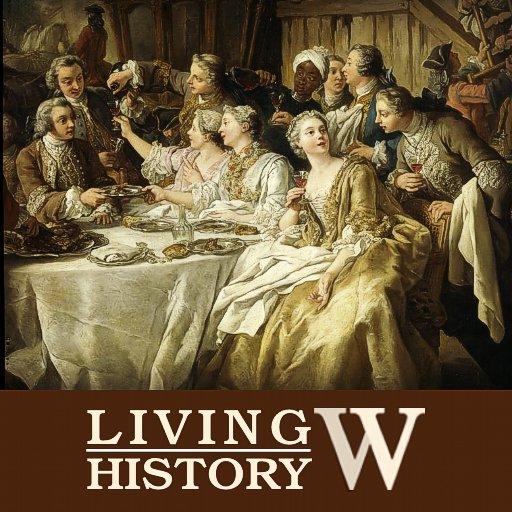LA XIII DUQUESA DE ALBA
Mara del Pilar Teresa Cayetana de Silva y lvarez de Toledo, 13 duquesa de Alba; Madrid, 1762 - 1802) Noble espaola. Nieta del duodcimo duque de Alba, Fernando de Silva y lvarez de Toledo, hered la titularidad del Ducado de Alba en 1776, fecha de la muerte de su abuelo, y fue una de las mujeres ms ricas de su tiempo y una de las aristcratas con ms ttulos del mundo. Su vida, envuelta en leyendas que siguen siendo motivo de discusin, escandaliz a la aristocracia de la poca y fue fuente de inspiracin para artistas; de hecho, la decimotercera duquesa de Alba es particularmente recordada por las tempestuosas relaciones que mantuvo con el pintor Francisco de Goya, que la retrat en varias ocasiones.
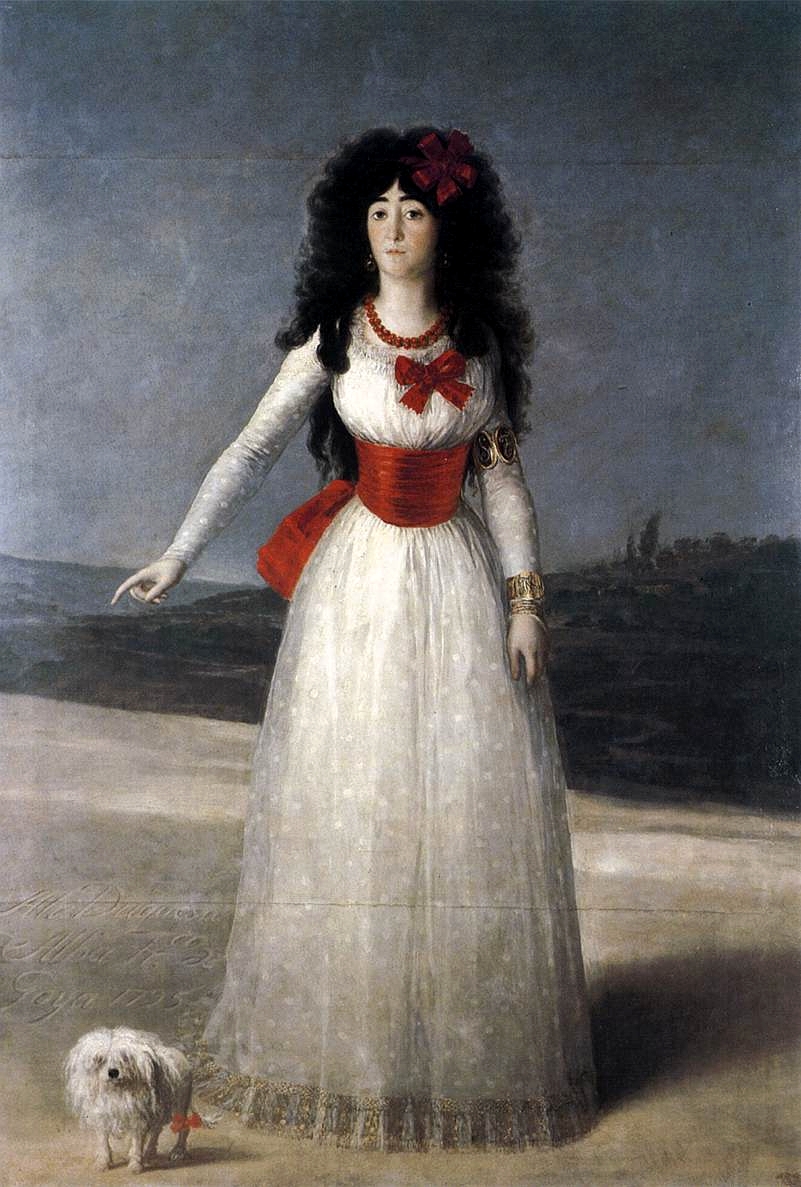
Nacida en Madrid el 10 de junio de 1762, era hija de Francisco de Paula de Silva y lvarez de Toledo, decimotercer duque de Huescar, y de Mara del Pilar Ana de Silva y Sarmiento de Sotomayor, descendiente del conde de Salvatierra y octava marquesa de Santa Cruz. Cayetana pas los primeros aos de su vida en el viejo palacio de la Casa de Alba, en el centro de Madrid.
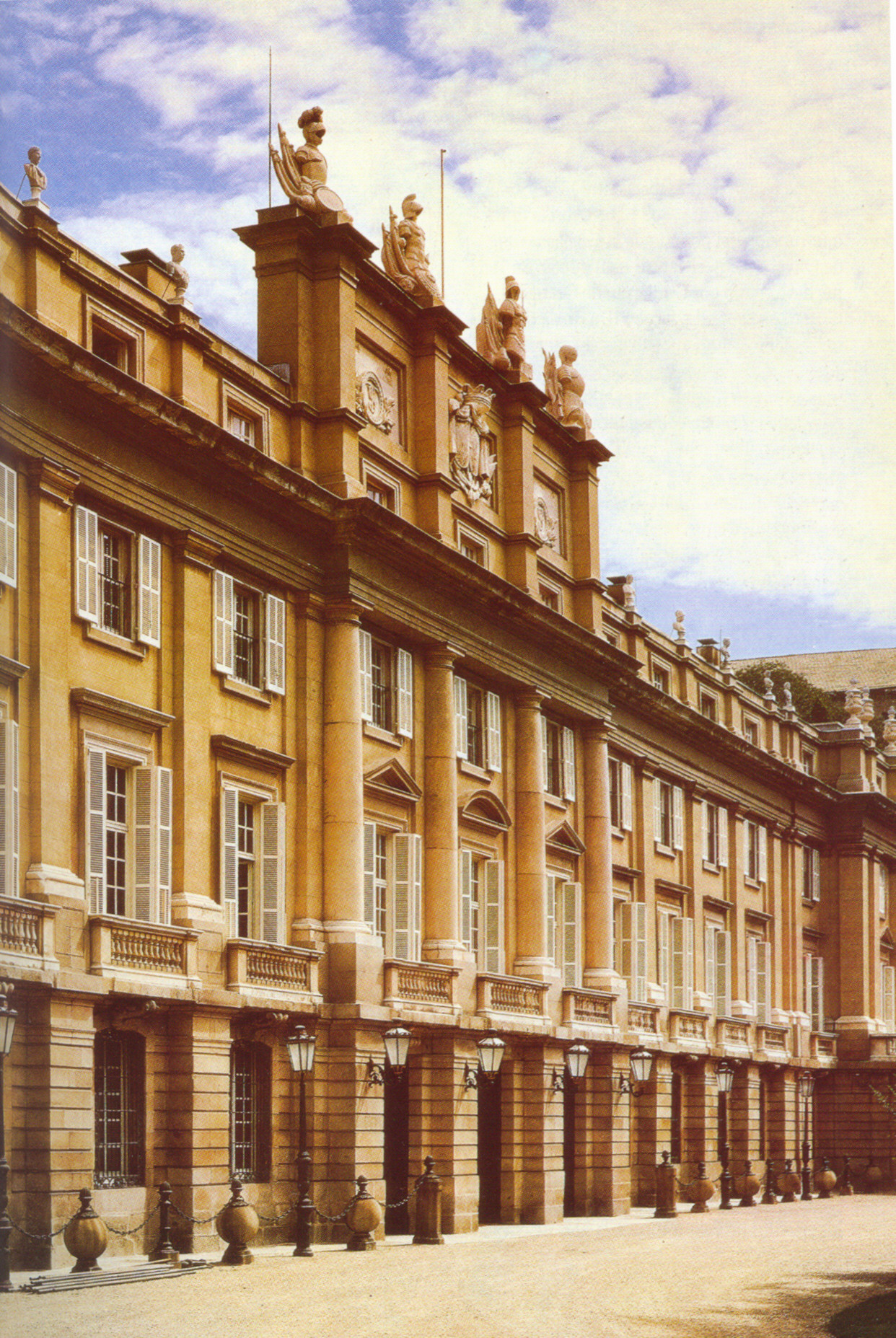
En 1770 falleci su padre, por lo que Cayetana se convirti en la nica heredera de su anciano abuelo Fernando de Silva y lvarez de Toledo, duodcimo duque de Alba. En 1775, Fernando de Silva concert el matrimonio de Mara del Pilar Teresa Cayetana con Jos Mara lvarez de Toledo y Gonzaga y Prez de Guzmn, 16 duque de Medina Sidonia y primo de Cayetana. Algunos estudios mantienen que esta eleccin respondi al deseo del anciano Fernando de Silva de restaurar el apellido lvarez de Toledo en el ducado de Alba. Aunque el matrimonio se celebr, no pudo consumarse hasta un tiempo despus, ya que Cayetana, con doce aos de edad, no haba tenido an su primera menstruacin.
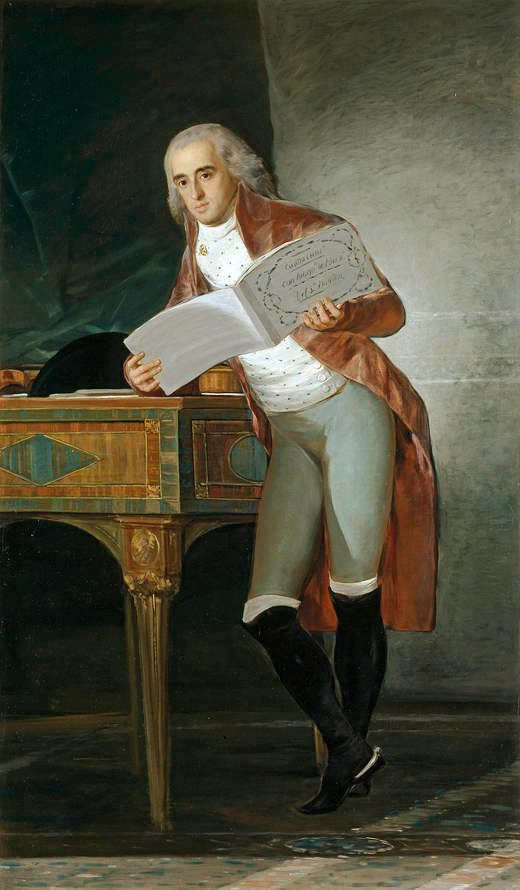
Cayetana no era feliz junto a su esposo y volvi a sus tradicionales escapadas por las calles de Madrid; segn se cuenta, se disfrazaba de maja y tomaba parte en las fiestas populares. Por estas fechas, la joven esposa comenz a organizar una serie de grandes festejos en su palacio a los que invitaba al pueblo llano, lo que caus gran escndalo entre la aristocracia espaola, poco inclinada a mezclarse con el pueblo.
Tras la muerte de su abuelo en 1776, Cayetana se convirti, a sus quince aos, en la decimotercera duquesa de Alba; era la segunda mujer que heredaba el Ducado por derecho propio. Cayetana hered adems de su abuelo ms de veinte ttulos y cinco grandezas de Espaa, con el correspondiente patrimonio que incluan, a los que aadi los inmensos estados de la Casa de Oropesa, heredada de su abuela paterna. Pronto se convirti en uno de los personajes ms importantes e influyentes de la Corte.
Entretanto, su madre se haba vuelto a casar con el duque italiano Joaqun Pignatelli, que tena hijos de un matrimonio anterior. Uno de ellos, Juan Pignatelli, se convirti en el gran amor de la joven duquesa de Alba. Con su relacin con Juan Pignatelli (que supuso otro escndalo para la aristocracia espaola), la duquesa de Alba se gan la enemistad de la princesa de Asturias, Mara Luisa, que tambin pretenda los favores de Pignatelli. Desde este momento, la rivalidad entre ambas damas se convirti en una constante de sus vidas, destinada a perdurar incluso despus de perder el inters por Pignatelli.
As, Cayetana conspir contra Manuel de Godoy cuando ste se convirti en el supuesto nuevo amante de la ya entonces reina. Cierto es que tras esta animadversin personal entre la soberana y la duquesa de Alba se encierra la verdad histrica del resentimiento de la alta nobleza frente al favoritismo del que era objeto Godoy, a quien la nobleza consideraba un advenedizo que deba su posicin a la debilidad del monarca, Carlos IV, y a los favores de la reina. Teresa Cayetana mantuvo tambin una profunda enemistad con la duquesa de Osuna, en este caso ms por celos que por razones polticas.
Una conocida ancdota ilustra la profunda animadversin entre la princesa de Asturias y la duquesa de Alba. En cierta ocasin la princesa Mara Luisa regal una fabulosa cajita de oro y diamantes a Juan Pignatelli, quien, a su vez, la regal a la duquesa de Alba. La duquesa le compens con el regalo de una valiosa sortija que Pignatelli regal tambin a la princesa. Mara Luisa, consciente de la procedencia de la sortija, la luci en un besamanos al que asisti Cayetana, que no tuvo ms remedio que besar la sortija. Humillada, la duquesa de Alba prepar su venganza; enterada igualmente de la procedencia de la cajita de oro, se la regal a los cortesanos de Mara Luisa, que mont en clera. Poco despus, Mara Luisa recibi de la reina de Francia una lujosa cadena de oro que luci en una cena de palacio a la que la duquesa estaba invitada; tal cadena despert una gran admiracin en la Corte. Cayetana orden que se hicieran un centenar de copias que reparti entre la servidumbre de la reina. Tras semejante intercambio de afrentas, la princesa presion a su esposo para que enviase a Juan Pignatelli a la embajada en Pars
Cayetana, cansada de las intrigas de la Corte, abandon Madrid y fij su residencia entre el palacio abulense de Piedrahita y el gaditano de Sanlcar de Barrameda. Fue en esta poca cuando apareci la figura de Francisco de Goya en la vida de la duquesa. Aqu la historia se confunde ms que nunca con la leyenda. Al parecer, Goya conoci a la duquesa de Alba hacia 1790, cuando, de la mano de la duquesa de Osuna, el pintor aragons ingres en los crculos aristocrticos de la Corte madrilea. Cinco aos ms tarde, Goya realiz un retrato de la duquesa y otro de su esposo.
La historia que identifica a las majas de los dos cuadros de Goya (La maja vestida y La maja desnuda) con la duquesa de Alba se fundamenta en la conocida relacin entre el pintor y la duquesa y en el hecho de que, cuando se supone que se pintaron estos cuadros, ambos se encontraban juntos en Sanlcar de Barrameda, adonde haban ido tras la muerte del marido de la duquesa, el 9 de junio de 1796. Se ignora la fecha exacta en la que Goya pint La maja desnuda, pero se sabe que fue antes de 1800, ya que en esa fecha la obra se encontraba en el gabinete de Godoy. Dada la enemistad entre la duquesa y Godoy, es difcil explicar cmo el cuadro acab en su gabinete si la retratada fuera la duquesa, a no ser que se d crdito a otra leyenda, an ms improbable, que convierte a Cayetana y a Godoy en amantes. Todo parece indicar que fue el propio Godoy quien encarg a Goya La maja desnuda, mxime si se tiene en cuenta la aficin del ministro por los cuadros de esta temtica.
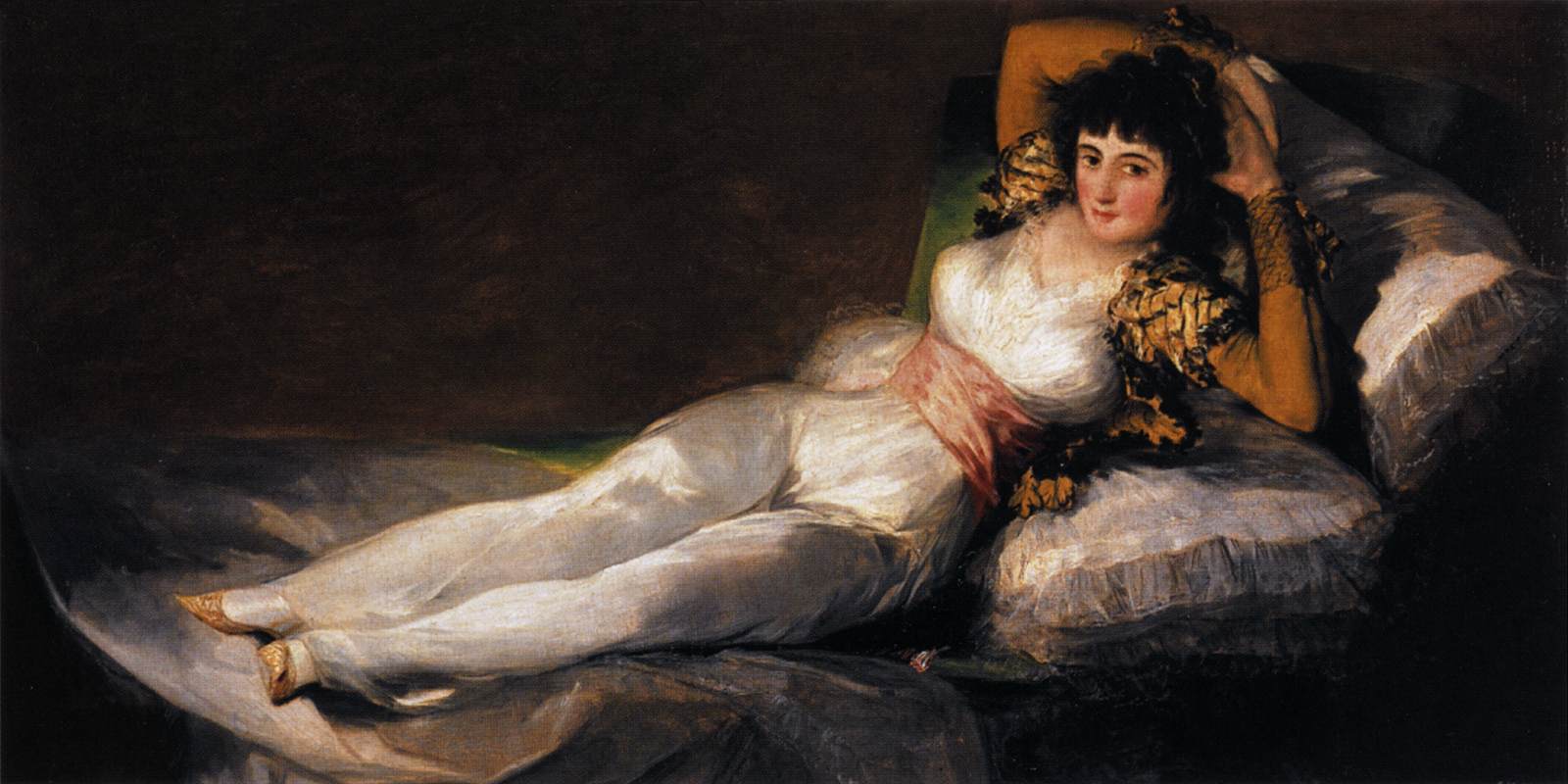
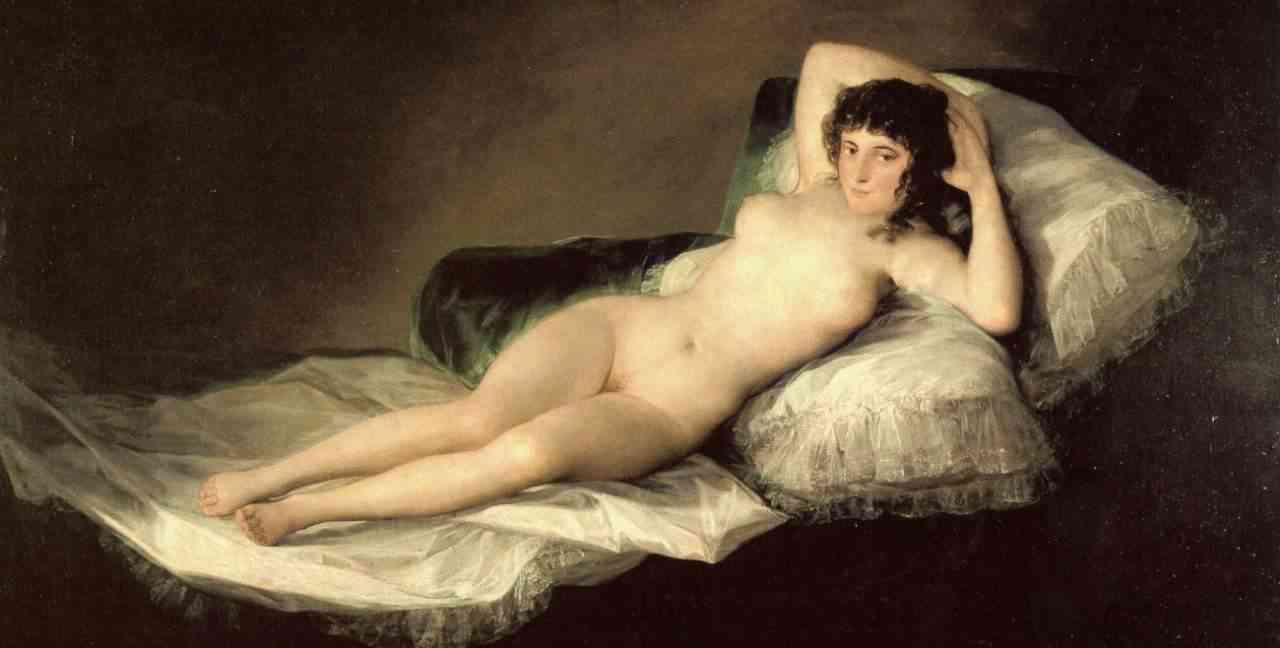
Con todo, el cuadro sigue teniendo algo de enigmtico. No hay duda de que el rostro no se corresponde con el de la duquesa (es un rostro idealizado que no corresponde a nadie concreto), pero el cuerpo si podra ser el de Cayetana, segn se comprob en 1945, cuando el duque de Alba exhum los restos de su antepasada para tratar de restar crdito a la leyenda de la maja. La exhumacin mostr un hecho tambin misterioso: al cadver le faltaba un pie. Extraamente, cuando se exhum el cadver de Goya, se hall que le faltaba la cabeza.
Son muchos los aspectos de la vida de la duquesa de Alba envueltos en la leyenda y el misterio; ni siquiera son claras las causas de su prematuro fallecimiento: envenenamiento, suicidio o fiebres son algunas diversas hiptesis que se han manejado. Tras su muerte sin descendencia, la casa de Alba transmiti sus derechos sucesorios a los Fitz-James Stuart, duques de Berwick, y sigui acumulando junto con los ttulos nobiliarios uno de los mayores patrimonios de Espaa.
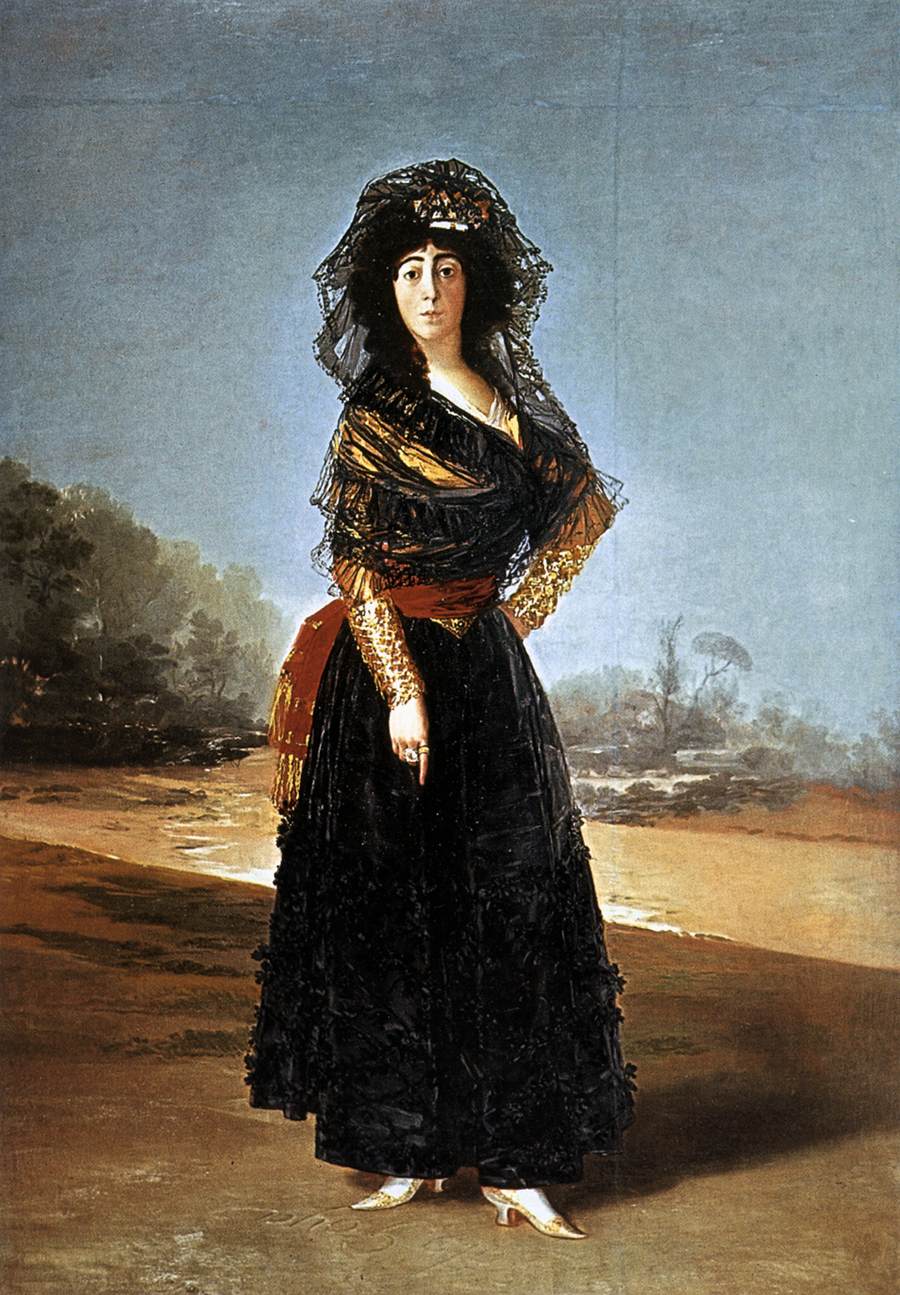
*******************************************************************************
( Maria del Pilar Teresa Cayetana of Silva and lvarez of Toledo, 13 duchess of Alba; Madrid, 1762 - 1802) Noble Spanish woman. Granddaughter of the twelfth duke of Alba, Fernando of Forest and lvarez of Toledo, inherited the ownership of Alba's Duchy in 1776, date of the death of his grandfather, and was one of the richest women of his time and one of the aristocrats with more titles of the world. His life, wrapped in legends that continue being a motive of discussion, made a fuss to the aristocracy of the epoch and was a source of inspiration for artists; of fact, the thirteenth duchess of Alba is particularly remembered by the stormy relations that it supported with the painter Francisco of Goya, that it portrayed her in several occasions.
Born in Madrid on June 10, 1762, it was daughter of Francisco de Paula of Forest and lvarez of Toledo, decimotercer duke of Huescar, and of Maria del Pilar Ana of Forest and Vineshoot of Sotomayor, descendant of the count of Salvatierra and eighth marquise of Santa Cruz. Cayetana happened the first years of his life in the old palace of Alba's House, in the center of Madrid.
In 1770 his father died, for what Cayetana turned into the only inheritor of his elderly grandfather Fernando of Forest and lvarez of Toledo, twelfth duke of Alba. In 1775, Fernando of Forest coordinated Maria del Pilar's Teresa marriage Cayetana with Jose Maria lvarez of Toledo and Gonzaga and Perez de Guzmn, 16 duke of Medina Sidonia and cousin of Cayetana. Some studies support that this choice answered to the desire of the elder Fernando of Forest to restore the surname lvarez of Toledo in Alba's duchy. Though the marriage was celebrated, it could not consumarse up to a time later, since Cayetana, with twelve years of age, had not had still his first menstruation.
Cayetana was not happy together with his husband and it returned to his traditional elopements for the streets of Madrid; as one counts, it was disguising itself as beauty and was taking part in the popular holidays. In these dates, the young woman handcuffs it began to organize a series of big feasts in his palace to which he was inviting the ordinary people, which caused great scandal between the Spanish aristocracy, little inclined to be mixed by the people.
After the death of his grandfather in 1776, Cayetana turned, at his fifteen years, into the thirteenth duchess of Alba; she was the second woman who was inheriting the Duchy for own right. Cayetana inherited besides his grandfather more than twenty titles and five greatness of Spain, with the corresponding heritage that they were including, to that it added the immense conditions of Oropesa's House, inherited from his paternal grandmother. Soon it turned into one of the most important and influential prominent figures of the Court.
Meanwhile, his mother had returned to marry the Italian count Joaqun Pignatelli, who had children of a previous marriage. One of them, Juan Pignatelli, turned into the great love of the young woman duchess of Alba. With his relation with Juan Pignatelli (who supposed another scandal for the Spanish aristocracy), the duchess of Alba gained herself the hatred of the princess of Asturias, Maria Luisa, who also was claiming Pignatelli's favors. From this moment, the rivalry between both ladies turned into a constant of his lives, destined to last even after losing the interest for Pignatelli.
This way, Cayetana conspired against Manuel de Godoy when this one lover of the queen already at the time turned into the new supposition. Certain it is that after this personal ill-will between the sovereign one and the duchess of Alba there shuts in itself the historical truth of the resentment of the high nobility opposite to the favouritism of the one that was an object Godoy, whom the nobility was considering to be an upstart who owed his position to the weakness of the monarch, Carlos IV, and to the favors of the queen. Teresa Cayetana supported also a deep hatred with the duchess of Osuna, in this case more for jealousies than for political reasons.
A known anecdote illustrates the deep ill-will between the princess of Asturias and the duchess of Alba. In certain occasion the princess Maria Luisa gave a fabulous cajita of gold and diamonds to Juan Pignatelli, who, in turn, gave her to the duchess of Alba. The duchess compensated him with the gift of a valuable ring that Pignatelli gave also to the princess. Maria Luisa, conscious of the origin of the ring, her shone in a levee to the one that represented Cayetana, which did not have any more remedy that to kiss the ring. Humiliated, the duchess of Alba prepared his revenge; informed equally about the origin of the golden cajita, she was given to the courtiers of Maria Luisa, who mounted in rage.
. Little later, Maria Luisa received of the queen of France a luxurious chain of gold that shone in a dinner of palace to which the duchess was invited; such a chain woke a great admiration up in the Court. Cayetana ordered that there should do a hundred of copies that it distributed between the servitude of the queen. After similar exchange of affronts, the princess pressed his husband in order that he was sending Juan Pignatelli to the embassy in Paris.
Cayetana tired of the intrigues of the Court, left Madrid and there fixed his residence between the palace native of Avila of Piedrahita and the native of Cadiz of Sanlcar de Barrameda. It was in this epoch when Francisco's figure of Goya appeared in the life of the duchess. Here the history gets confused more than never with the legend. Apparently, Goya knew the duchess of Alba about 1790, when, of the hand of the duchess of Osuna, the Aragonese painter joined the aristocratic circles of the Court of Madrid. Five years later, Goya realized a portrait of the duchess and other one of his husband.
The history that identifies the beauties of both pictures of Goya (The dressed beauty and The beauty undresses) with the duchess of Alba is based on the known relation between the painter and the duchess and on the fact that, when it is supposed that these pictures made up, both were united in Sanlcar de Barrameda, to where they had gone after the death of the husband of the duchess, on June 9, 1796. It is ignored the exact date in which Goya painted The nake beauty, but it is known that it was before 1800, since in this date the work was in Godoy's office. . Given the hatred between the duchess and Godoy, is difficult to explain how the picture finished in his office if the portrayed one was the duchess, unless credit gives itself to another legend, furthermore improbably, that turns Cayetana and Godoy into lovers. Everything seems to indicate that it was the own Godoy who The nake beauty entrusted Goya, especially if the interest of the secretary is born in mind by the pictures of this subject matter.
With everything, the picture continues having something of enigmatically. There is no doubt that the face does not correspond with that of the duchess (it is an idealized face that does not correspond to concrete anybody), but the body if it might be that of Cayetana, as it was verified in 1945, when the duke of Alba exhumed the remains of his before last one to try to reduce credit to the legend of the beauty. The exhumation showed a fact also mysteriously: to the corpse he was lacking a foot. Strangly, when the corpse of Goya was exhumed, one found that he was lacking the head.
There are great the aspects of the life of the duchess of Alba wrapped in the legend and the mystery; there are not even clear the reasons of his premature death: poisoning, suicide or fevers are some diverse hypotheses that they have handled. After his death without descent, Alba's house there transmitted his death duties to the Fitz-woman's faces Stuart, dukes of Berwick, and continued accumulating together with the pertaining to nobility titles one of the major heritages of Spain.
A mi querida hija Cayetana.
To my dear daughter Cayetana.
updated by @maria-del-pilar-ana-de-silva-baz: 06 Oct 2016 06:09:54AM

